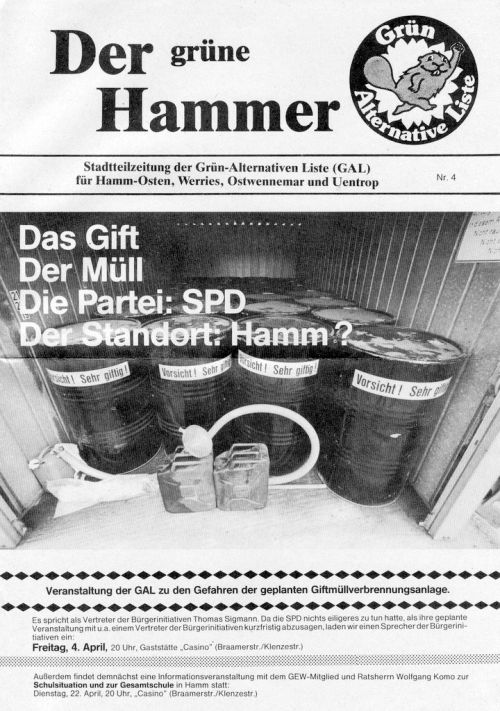| The reactor bankruptcy - THTR 300 | The THTR Circular |
| Studies on THTR and much more. | The THTR breakdown list |
| The HTR research | The THTR incident in the 'Spiegel' |
The THTR Circulars from 2015
***
| 2023 | 2022 | 2021 | 2020 | ||
| 2019 | 2018 | 2017 | 2016 | 2015 | 2014 |
| 2013 | 2012 | 2011 | 2010 | 2009 | 2008 |
| 2007 | 2006 | 2005 | 2004 | 2003 | 2002 |
THTR Circular No. 146, December 2015:
Content:
China: New plans and well-known bankruptcies
Generation IV reactors: Setting the course for the next 10 years
3sat - broadcast takes over the rhetoric of the nuclear industry!
What will happen to the 152 castors in Jülich?
Hannelore Kraft ignores climate protection and human rights
Obituary: Wolfgang Zucht has died
Civil disobedience and democracy
China: New plans and well-known bankruptcies - Two new high-temperature reactors planned in Ruijin
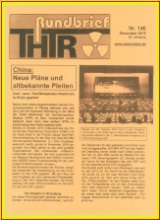 In addition to the mostly shut down small research reactor in Beijing, a high-temperature reactor (HTR) has been under construction on the Shandong peninsula near the city of Shidaowan since 2012. It has since been announced that two more HTRs are planned in Ruijin, southern China.
In addition to the mostly shut down small research reactor in Beijing, a high-temperature reactor (HTR) has been under construction on the Shandong peninsula near the city of Shidaowan since 2012. It has since been announced that two more HTRs are planned in Ruijin, southern China.
In October 2013, the China Nuclear Engineering Corporation (CNEC) signed a framework agreement with the city of Ruijin in Jiangxi Province for the construction of two 600 MW high-temperature reactors (1). A project company for this was founded in November 2014. The CNEC is one of the ten largest organizations in the Chinese military-industrial complex. Together with the National Development and Reform Commission (NDRC), it will present a project proposal for the national development plan.
The Jiangxi Provincial Development Commission has now given approval for the preliminary work for the HTR. According to the press release mentioned above, construction is to begin in 2017. Completion and first electricity production is therefore planned for 2021.
The reactor in Shandong
In order to be able to classify these announcements more precisely, it makes sense to look back at how the time frame for the planned and still unfinished 200 MW HTR on the Shandong peninsula has shifted further and further back: In 2005, the location for the new HTR was announced (2). At that time, the date given for the start of construction was 2007 and the date for commissioning in 2010.
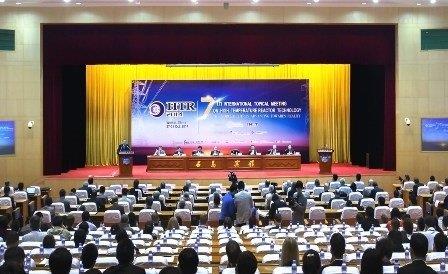
The reality is different: construction only started in 2012 (3). Until a few months ago, the end of 2015 was given as the date for commissioning (4). Now it will be the end of 2017. The "civil engineering work" for the reactor is about to be completed and the interior work can soon begin, they say. Even if this deadline were actually met, it would be a proud eight years of construction! - In any case, no rapid construction progress can be seen here.
What remains is the fuel element factory for the planned HTR in Baotou in Inner Mongolia (5). In THTR circular no.144, we reported, with reference to a Chinese source, that after construction began in February 2013, the factory for the annual production of the 300.000 fuel elements was completed in September 2014 (6). In the meantime, this link no longer exists and it was mentioned elsewhere as the date of August 2015 (7). So far, however, nothing has been known of the actual commissioning of the nuclear fuel factory.
1. http://www.world-nuclear-news.org/NN-Ruijin-HTR-plant-proposal-progresses-2704154.html
2. http://www.machtvonunten.de/atomkraft-und-oekologie/180-nukleare-premiere.html
4. http://www.world-nuclear-news.org/ENF-Irradiation-trials-of-HTR-PM-fuel-completed-0501154.html
5. see note 3.
6. see note 3.
7. see note 4.
Generation IV reactors:Setting the course for the next 10 years |
This year the framework agreement on international cooperation in the research and development of 4th generation nuclear power plants was extended by ten years. This was announced by the Generation IV International Forum (GIF). The development and research of the HTR reactor line is one of the main focuses of this alliance. This took place in 2000 on the initiative of the USA.
Today 13 countries are involved. Ten of them, namely China, France, Japan, Canada, Russia, Switzerland (via the Paul Scherrer Institute), South Africa, South Korea, the USA and Euratom have signed the framework agreement and are considered GIF members. Argentina, Brazil and the UK are inactive members. Through the membership of Euratom, German research institutes, in particular the Forschungszentrum Jülich (FZJ), can participate in the further development of these reactors disguised as safety research despite the nuclear phase-out (1).
Again and again South Africa
In this context, it is of particular interest that on September 15, 9, South Africa extended its cooperation with the GIF. On this day, the South African energy minister Tina Joemat-Pettersson signed the framework agreement for the next ten years (2). As a reminder: South Africa invested a total of over a billion dollars in the development of the Pebble Bed Modular Reactor (PBMR), but ultimately had to accept that such a demanding project could not be tackled in the crisis-ridden emerging market (3). In 2009 the PBMR was stopped.
Obviously, only six years later, a new generation of stubborn and ambitious politicians will not give up their nuclear visions. At the beginning of July, an agreement between South Africa and the Russian state-owned company Rosatom was signed that includes comprehensive training programs for 200 students in Russia, as well as the provision of specialist literature on the subject of nuclear energy. A broad-based nuclear propaganda offensive is also planned: "The residents' awareness of the use of advanced nuclear technologies in the energy industry and other sectors is to be increased and public acceptance for the use of nuclear energy increased" (4). After the gigantic waste of public funds on the giant flop PBMR, this obviously seems necessary ...
Opportunism and the Wild West
This year, nuclear cooperation between China and South Africa was also expanded. On April 21, 2015, the China Nuclear Engineering Group Corporation (CNEC) and the South African Nuclear Energy Corporation Ltd (Necsa) agreed to work together on the construction of a high-temperature reactor in South Africa within the next ten years (5). The South African Ambassador to China, Dolana Mismang, signed the agreement during a ceremony. “The revitalization of the nuclear industry in South Africa” is also named as a goal. This also includes the exploitation of uranium mines and uranium enrichment.
The cooperation between China and South Africa is extremely spicy in light of the latest revelations: a few weeks before the contract was signed, various media revealed information from South African intelligence sources that the mysterious attack, including the exchange of fire, in the South African nuclear center of Pelindaba in 2007 by armed Chinese agents (6). The prey of the Chinese: documents for the construction of high-temperature reactors!
After its own completely failed attempt to build the PBMR, the disgraced South African atomic energy organization is now on the mat of the economically and technologically potent Chinese to ask for support from precisely those who stole important know-how from them eight years earlier using wild west methods. - A lesson in how rude and opportunistic is to be dealt with between "partners" when using a highly dangerous technology.
1. http://www.reaktorpleite.de/nr.-122-august-08.html
2. http://www.nuklearforum.ch/de/aktuell/e-bulletin/suedafrika-verlaengert-gif-zusammenarbeit
4. http://www.nuklearforum.ch/de/aktuell/e-bulletin/rosatom-staerkung-der-zusammenarbeit-mit-suedafrika
5. http://www.cnecc.com/en/tabid/665/SourceId/1462/InfoID/18114/language/zh-CN/Default.aspx
6. http://www.reaktorpleite.de/57-sp-590/rundbriefe-2015/522-thtr-rundbrief-nr-145-mai-2015.html
3sat - broadcast takes over the rhetoric of the nuclear industry! |
On October 29, 2015, 3sat broadcast the science documentary "Tabu Nuclear Research", in which students of nuclear engineering and their professors, who are sensitively staged, complain bitterly that their "skills" will no longer be in demand in Germany in the future because of the nuclear phase-out may have to migrate abroad.
In contrast, in the program, opponents of nuclear power plants are portrayed as people who no longer really know how to deal with nuclear waste and the reactor ruins and who, on top of that, block themselves against competent scientific research that looks for possible solutions. The prudent and forward-looking nuclear scientists, however, would be prevented from conducting urgently needed safety research. This tenor runs through the entire film. - An impudence!
The fact that precisely these nuclear scientists were responsible for a large part of the nuclear power plant incidents and their cover-up is concealed in the film. They would like to sabotage the exit and continue to experiment with running nuclear power plants. "Germany is running out of nuclear specialists, capable minds are migrating abroad, we are losing important know-how" - this is the one-sided message of this PR film by the public broadcaster 3sat.
That's why I spontaneously posted the following on the 3sat Facebook page:
"Why does the Jülich professor Allelein have his say in detail in the film, who has played down and glossed over the incidents at AVR Jülich for years and never made a secret of the fact that he prefers to continue developing the high-temperature reactor line despite the decision to exit and high safety risks want to continue? - And why does the whistleblower award winner Rainer Moormann come, who uncovered these incidents and even received a lot of attention from many nuclear scientists on an international level, why does Rainer Moormann not have his say in this film? Why does this film take over the rhetoric of the nuclear industry ("We have benefited from nuclear power ..."), even though society had to raise billions of euros in hidden extra subsidies for this bankruptcy technology? "
The film was not made without intention: Professor Allelein will retire in 2017 and would like his chair to continue researching the HTR line with the hypocritical argument of “competence for dismantling”. It would be much more sensible and, above all, clearer if this dismantling were to be integrated into the newly established RWTH Disposal Association. But that is exactly what the nuclear lobby wants to prevent in the next few months and is harnessing the media for these selfish interests. The red-green state government of North Rhine-Westphalia could exert influence and ensure that designated representatives of the energy transition in the future set the tone in research institutions and not the narrow-minded advocates of a form of energy that has long been voted out by voters in the Federal Republic.
With 3sat, however, a publicly financed television station has allowed itself to be misused as a propaganda tool for the nuclear industry.
The 3sat film can be viewed here:
http://www.3sat.de/mediathek/?mode=play&obj=54594
What will happen to the 152 castors in Jülich? |
Thousands of radioactive fuel element balls from the long-decommissioned test power plant AVR are stored in Jülich. It is still unclear where they should be taken: to the Ahaus interim storage facility, the USA or a new Jülich interim storage facility.
The anti-nuclear initiatives of the supraregional alliance against Castorexporte and the action alliance Münsterland against nuclear facilities view the Jülich nuclear waste debacle with great concern. Marita Boslar from the Alliance against Castor Exports: “Now the transport of the Jülich Castors to the Ahaus interim storage facility is becoming more and more likely! - As far as we know, the Federal Office for Radiation Protection is only processing the application to store the 152 castors in the Ahaus interim storage facility. "
New responsibilities - questions to BfS should shed light on the darkness
For a few months now, Forschungszentrum Jülich (FZJ) has no longer been responsible for nuclear waste. A new Jülich waste disposal company for nuclear plants mbH (JEN) was founded. She is responsible for the dismantling of the AVR and for the further handling of the approximately 300 fuel elements stored in 000 castor casks. "In order to shed light on this, we have now sent the Federal Office for Radiation Protection (BfS) a very specific list of questions," says Peter Bastian. The anti-nuclear power initiatives want to know exactly which options the JEN have discussed with the Federal Office for Radiation Protection and for which option applications have been made. "Unfortunately, we have to assume that the research center never submitted the earthquake safety investigations at the Jülich site that were required at the time and that the process for further storage of the nuclear waste in Jülich is no longer being processed," says Peter Bastian, disappointed. "We also asked the Federal Office specific questions about this."
Will Castor transports start in 2016?
The Federal Office for Radiation Protection has announced that the approval process for the storage of the 152 AVR castors in Ahaus will be completed at the turn of the year. That is why the initiatives have asked for a prompt response. Marlies Schmidt ventures her anger: "It can be assumed that - as is so often the case - the holidays are being misused to announce an unpleasant decision." use the new building in Jülich and against the Castor transports. "
At the end of the year, the opponents of nuclear power invite you to take a Christmas Sunday stroll on December 20 at 14 p.m. in front of the Ahaus interim storage facility!
For a new interim storage facility in Jülich!
"The Castor debacle makes it clear that Forschungszentrum Jülich has never seriously looked after its nuclear waste," emphasizes Siegfried Faust. There is only one solution for those who oppose nuclear power: to build a new, safe interim storage facility at the research center in Jülich. Because only there can the castors be opened and the highly porous and flammable spheres packed for final disposal. This is not possible in the Ahaus interim storage facility. For later repairs, the castors would have to return from Ahaus to Jülich because there is no so-called “hot cell” there. Siegfried Faust: “180 kilometers across North Rhine-Westphalia to Ahaus, that is dangerous and irresponsible. The people in North Rhine-Westphalia bear the costs and risks. Incidents would affect people who live along the route, but also police officers who have to secure transport. "
Joint press release of the alliance against Castorexporte and the action alliance Münsterland against nuclear facilities from November 27th, 11
Hannelore Kraft ignores climate protection and human rights |
During her trip to Colombia from November 25th to 27th, NRW Prime Minister Hannelore Kraft advertised companies in North Rhine-Westphalia, largely ignoring controversial issues such as climate protection and human rights violations in connection with coal mining.
The large business delegation that accompanied Kraft included representatives from the STEAG electricity company, which imports Colombian hard coal, as well as from companies in the coal mining sector. The coal sector in particular has long been criticized in Colombia and other countries for human rights violations and environmental degradation. According to information from the media and representatives of non-governmental organizations, Kraft did not go into more detail on accounts of trade union representatives and human rights activists and instead stated: "I cannot assess that, the human rights issues need to be clarified here on the ground, in particular."
The organizations kolko, Powershift and urgewald criticize this attitude of Kraft: “In the coal-mining regions of Colombia, thousands of people were killed and tens of thousands displaced. Numerous witnesses have testified under oath that coal companies helped finance the murderous gangs. Despite these well-known allegations, the social democrat Hannelore Kraft advertises NRW mining technology without asking critical questions of the coal companies present, ”said Sebastian Rötters from PowerShift.
“Ms. Kraft missed an important opportunity to support those who stand up for their land rights and a functioning constitutional state and who have received many death threats for doing so. Human rights issues must not be subordinated to economic interests, ”demands Alexandra Huck from kolko - human rights for Colombia.
“While the coal phase-out is being discussed in Germany and around the climate summit in Paris, Ms. Kraft is going to Colombia to sell coal mining technology. That is the completely wrong signal ”, says Heffa Schücking, managing director of urgewald.
From: Press release from “urgewald” dated December 3, 2015. - More information about the coal lobbyist Hannelore Kraft:
http://www.machtvonunten.de/atomkraft-und-oekologie/204-kohle-kraft-der-egoismus-regiert.html
Obituary: Wolfgang Zucht has died |
On September 17, 2015, Wolfgang Zucht, an important initiator during the founding and initial phase of the Hamm citizens' initiative, died at the age of 86.
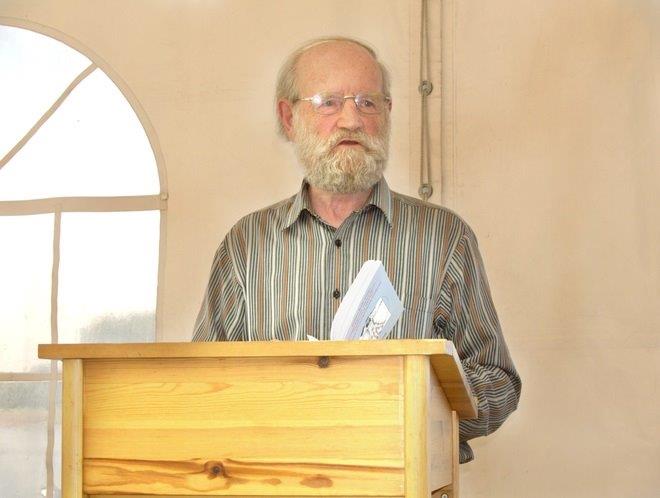
Together with his wife Helga Weber-Zucht, he had unobtrusively, but all the more sustainably, helped shape many citizens' initiatives against nuclear power plants since the 70s. Since Wolfgang was secretary of War Resisters International (WRI) in London from 1965 to 1973, he was able to draw on a wealth of experience of international nonviolent movements that were largely unknown in the Federal Republic of Germany.
As “grass roots workshop” workers, Helga and Wolfgang published the “INFOrmation Service for Nonviolent Organizers” in Kassel from 1974 to 1980, numerous editions of which also reached Hamm, were read here and from which a lively correspondence in this INFO developed.
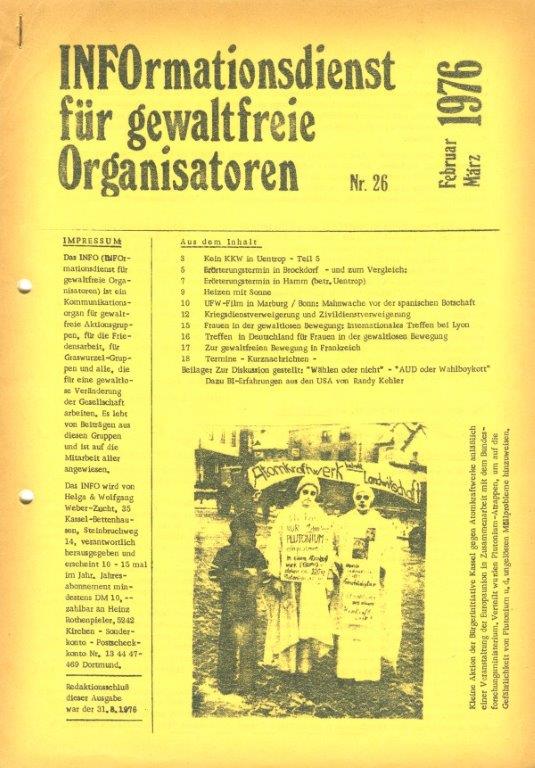 For many years, the workshop and INFO have not only become a unique hub for otherwise difficult to obtain information, but also for extremely useful experience reports and reflections that were important during the founding phase of citizens' initiatives. Because before 1973 BIs did not exist in their present form. We broke new ground in Hamm in 1975 when we were preparing to found our citizens' initiative, and as young people we were quite inexperienced. Here we could learn without being taught.
For many years, the workshop and INFO have not only become a unique hub for otherwise difficult to obtain information, but also for extremely useful experience reports and reflections that were important during the founding phase of citizens' initiatives. Because before 1973 BIs did not exist in their present form. We broke new ground in Hamm in 1975 when we were preparing to found our citizens' initiative, and as young people we were quite inexperienced. Here we could learn without being taught.
From social democrats to Maoists, many wanted to influence us and very often forced supposedly “good advice” on us without being asked. Helga and Wolfgang, on the other hand, never tried to persuade anyone, but with them different people and groups were able to present their respective perspectives and experiences on a particular problem in the INFO. In the subsequent sometimes lengthy discussions, a result usually emerged that was very helpful for many.
In this “INFO” a total of 19 reports were written about the founding phase of Hammer BI, mostly by Theo Hengesbach, who has since passed away. The tent camp in Frielinghausen, the occupation of the building site by the “VEW Information Center”, the rural youth events, folk festival and rally at the THTR, the discussion date for the second planned nuclear power plant in Hamm and, for the first time in the history of the environmental protection movement, an interfering participation in the VEW shareholders' meeting in Dortmund. In this INFO one could also find out how other initiatives fared, how they dealt with recurring problems such as the discussion of the question of violence and how they assess the current energy policy.
Particularly important to Wolfgang was the support of the movement to refuse electricity, in which 10 percent of the electricity bill was paid into an escrow account as a protest against nuclear power plants. In 1977 he wrote several chapters about experiences in other countries with similar campaigns of civil disobedience for the booklet “No nuclear power plant with our money!”, Which was published by the Welveraner pastor Michael Schweizer and Theo Hengesbach.
We in Hamm supported this campaign by distributing four thousand leaflets and our own articles in our city newspapers “Der Grüne Hammer” and “Uentroper Umweltzeitung”. The booklet was distributed by the "Versandbuchhandlung Helga und Wolfgang Weber-Zucht", along with hundreds of other publications. From this developed the most comprehensive and best-stocked mail-order bookstore on the subject of nonviolent actions and pacifism in the entire German-speaking area, present and highly valued at many congresses, seminars, action conferences and book fairs. A separate publishing house was set up with books by and about Gandhi, ML King and the Lanza del Vasto, much appreciated by Wolfgang (for which a group of three from Hamm in Larzac in the south of France even set out at the end of the 70s ...).
In 1978, in a letter to the editor of the “Graswurzelrevolution”, I wrote in issue 33: “I have observed that many people in the citizens 'initiative prefer to read the Kassel' Info 'rather than the' Grassroots Revolution ', which may be due to the fact that the' Info 'Is written more personally and contains more background reports on the situation and work of BIs and groups'. It is astonishing that this extraordinary newspaper received hardly any attention within the much-researched media landscape. Perhaps it is also due to the fact that the researchers' focus was too much on paper and therefore they did not notice other important facts: Wolfgang's friendly, sympathetic and modest demeanor cannot be adequately represented in a paper format.
Later I got to know Wolfgang better at the all-day editorial meeting of the “grass roots revolution”. While I often rushed around impatiently and annoyed in my chair during some complicated and protracted discussions, Wolfgang listened attentively and patiently in such situations, usually only to say something profound later on. "The loud tones that were said quickly out of excitement were not his thing," wrote Elmar Klink very accurately in his obituary.
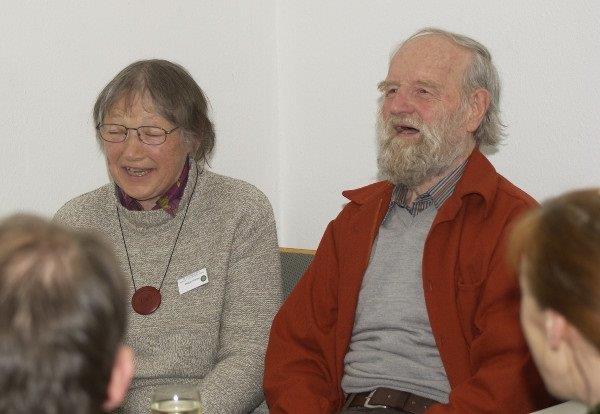
In his publishing house, which he runs with Helga, Wolfgang also brought the book “Action plan for social movements. A Strategic Framework for Successful Social Movements ”. Moyer's “Movement Action Plan” (MAP) aims to stimulate citizens' initiatives to think long-term and, above all, to encourage them to build optimistically on their partial successes.
A central idea in this MAP is that each person can find his place in the resistance as an activist, reformer, rebel, silent helper, sporadic demonstrator or letter writer (etc.) in his own way and is needed.
The wave movements, the ups and downs of the mobilizations in the course of decades of resistance, are not a drama or worrying. Knowing about this "internal clock" of resistance saves us from great disappointments and excessive euphoria and has a long-term stabilizing effect. These insights have been of great help to me over the past 40 years.
In the obituary notice for Wolfgang in the TAZ there was a quote from Bart de Ligt: "New ideas are only known because of the perseverance of a daring minority!" did Wolfgang all his life. I will miss him very much.
Horst Blume
The memorial page for Wolfgang Zucht can be viewed here:
http://www.dadaweb.de/wiki/Wolfgang_Zucht_-_Gedenkseite
Civil disobedience and democracyA long overdue contribution to the discussion about the resistance of citizens' initiatives |
Wolfgang Zucht wrote this article in 1980 in "Umweltmagazin" (No. 1), the newspaper of the "Federal Association of Citizens' Initiatives Environmental Protection" (BBU):
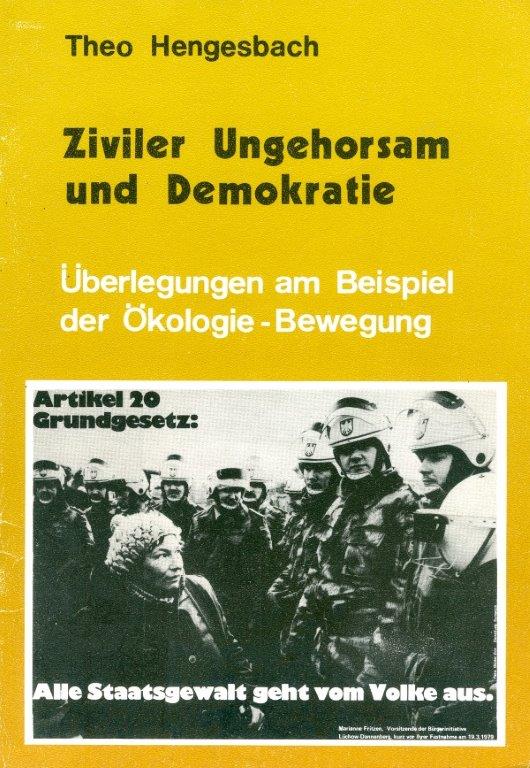 In the 30-year history of the Federal Republic of Germany there have repeatedly been groups of citizens inside and outside the large organizations such as trade unions, parties and churches who have tried in vain to get their voice heard or to assert their interests. If we look at other countries, we find that the situation is similar in almost all parliamentary democracies.
In the 30-year history of the Federal Republic of Germany there have repeatedly been groups of citizens inside and outside the large organizations such as trade unions, parties and churches who have tried in vain to get their voice heard or to assert their interests. If we look at other countries, we find that the situation is similar in almost all parliamentary democracies.
In the big organizations there is no place for minorities - that is where the majority rules. The formation of new political parties through 5% clauses and similar measures is a dead end, because it either does not lead to parliaments or to parliaments to ineffectiveness and a shadowy existence. If the citizens organize themselves, the rulers offer a one-way street dialogue from top to bottom. In doing so, they often behave in such a presumptuous manner that comparisons to the divine right of absolute monarchy are almost imposing.
Theo Hengesbach has now in his brochure "Civil disobedience and democracy - considerations based on the example of the ecological movement" pointed to a way to enforce interests, which, unlike the Anglo-Saxon countries in Germany, has no tradition and which restricts the power and rule of the rulers can strengthen the self-organization and self-government of the citizens and thus democracy. Here, for the first time in Germany, this form of resistance is discussed in somewhat more detail. It describes what “civil disobedience” is, how it works, and how it can be justified.
The right to resist as a reaction to the experiences in Nazi Germany has been included in the constitution of the Federal Republic of Germany. Significantly, the discussion about the right of resistance mostly refers to the necessity and legitimacy of resistance to dictatorships. Hengesbach, on the other hand, deals in detail with the question of “civil disobedience” in democracy and comes to the conclusion that “civil disobedience” is not only a corrective in a democracy, but also a grassroots democratic means to enforce new values.
What is particularly impressive about this brochure is the way in which three complexes are linked together so that they appear clear and understandable. Questions of the relationship between citizen and state are discussed and related to the previous discussions and actions of civil disobedience from Thoreau to Gandhi to the resistance against the Vietnam War in the USA. Finally, Hengesbach goes into the conflicts over atomic energy in the Federal Republic, where "civil disobedience" was discussed and carried out for the first time in Germany in a somewhat broader context.
This brochure is a long overdue contribution to exploring the importance of civil disobedience to citizens and the enforcement of their rights and interests restricted and suppressed by industry, government and bureaucracy.
Daniel Berrigan, who played a major role in the resistance against the Vietnam War in the USA, who took files of conscripts out of induction centers (comparable to our district military replacement offices) and doused them with napalm and blood and burned them, recently said of one Visit to the Federal Republic of Germany that the madness of atomic weapons could not be successfully combated without civil disobedience. The madness of atomic energy, on the other hand, is inconceivable without the madness of atomic weapons and the connection - see India, Pakistan, South Africa - can be felt at every turn.
Theo Hengesbach: “Civil disobedience and democracy”, 76 pages, 3 DM, mail order bookshop Weber-Zucht, Kassel.
Wolfgang Breeding
Dear readers! |
It's really sad: I had to write three obituaries this year. The obituary for Wolfgang Zucht can be found in this newsletter. Walter Mossmann, the most famous songwriter of the anti-nuclear movement, has died. My detailed article "The bird of life no longer sings" appeared in "Graswurzelrevolution" No. 401 and can be viewed here:
http://www.machtvonunten.de/musik/268-der-lebensvogel-singt-nicht-mehr.html
Also this year, Arno Klönne, the co-founder of the Easter march movement and an important advocate of the extra-parliamentary movement, died. My detailed article “A 'black' red” appeared in “Grassroots Revolution” No. 402 and can be viewed here:
http://www.machtvonunten.de/linke-bewegung/269-ein-schwarzer-roter.html
Anyone who wants to find out more about the local energy policy in Hamm and the surrounding area can visit the homepage “Hamm gegen Atom. Renewable energies for Hamm "exactly right:
In months of painstaking detailed work, Werner Neubauer created a nuclear world map on our website Reaktorpleite.de. From uranium mining and processing, to nuclear research and the construction and operation of nuclear facilities, to dealing with nuclear waste and nuclear weapons. Worldwide everything at a glance with Google Maps and numerous links and information:
http://www.reaktorpleite.de/karte-der-atomaren-welt.html
***
Top |
***
Donation appeal- The THTR-Rundbrief is published by 'BI Umwelt Hamm e. V. ' issued and financed by donations. - The THTR circular has meanwhile become a much-noticed information medium. However, there are ongoing costs due to the expansion of the website and the printing of additional information sheets. - The THTR circular researches and reports in detail. In order for us to be able to do that, we depend on donations. We are happy about every donation! Donations account:BI Umweltschutz Hamm |
***
Top |
***



